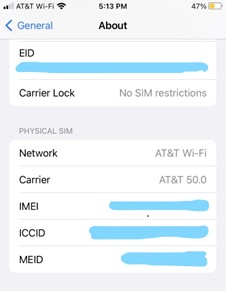Just kidding, we’ve got a plain-English definition for you: IMEI numbers are assigned to cell phones to help identify them, sort of like a social security number. This number can really come in handy if your phone has been lost or stolen, or if you’re purchasing a used device. Some older CDMA phones used an identifying number called MEID, and other phones have used something called an ESN number. But all new devices should have an IMEI number. Some older phones may have the IMEI listed on a sticker under the removable phone battery. You can also check your IMEI number on an iPhone by going to the Settings menu and selecting the About tab, then scrolling down. Users can also report the IMEI number as stolen, so that anyone who tries to resell the device might be caught (or at least unable to use the phone). But there’s always two sides when it comes to numbers that can be tracked … Technically, anyone with the right technology and access to the right networks may be able to track a phone’s IMEI. While we’re definitely not trying to hatch any tin-hat conspiracies here, some people worry that the government or hackers could use an IMEI number to track them. Play it safe and never share your IMEI number. For more basic phone safety make sure you know how to block a phone number too.
